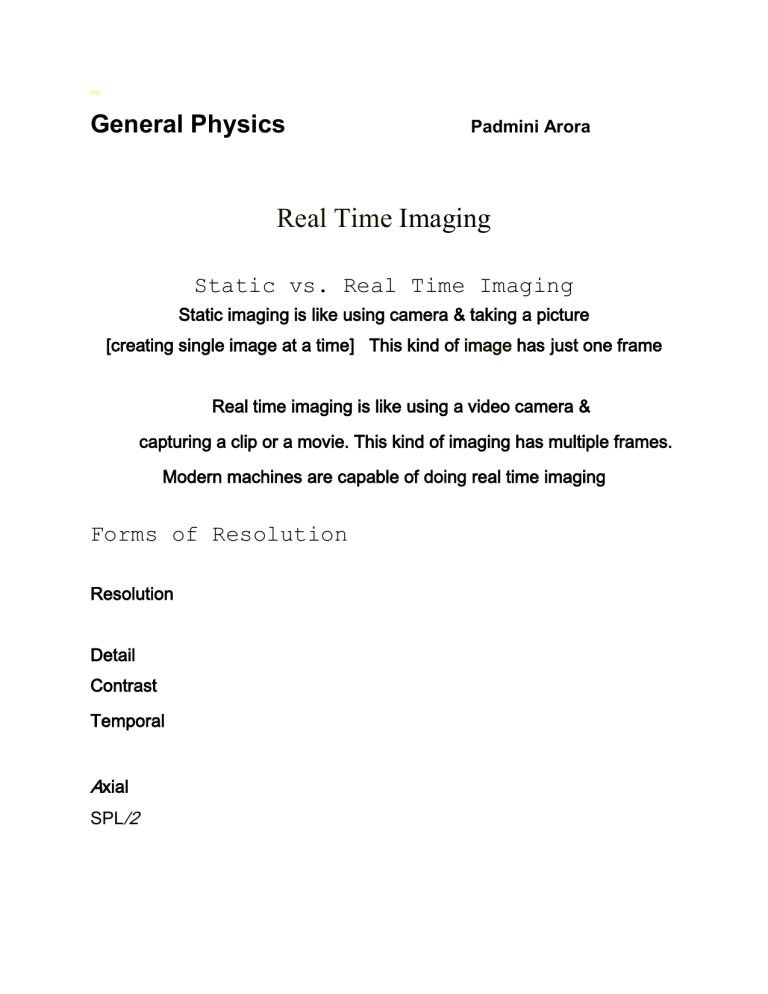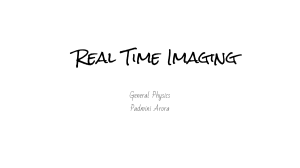
SAS General Physics Padmini Arora Real Time Imaging Static vs. Real Time Imaging Static imaging is like using camera & taking a picture [creating single image at a time] This kind of image has just one frame Real time imaging is like using a video camera & capturing a clip or a movie. This kind of imaging has multiple frames. Modern machines are capable of doing real time imaging Forms of Resolution Resolution Detail Contrast Temporal Axial SPL/2 Elevation • Elevation Beam Dimension Lateral Lateral Beam Dimension Scan Converter Depth (#Bits/Pixel) • Packet Size (Color) Post Processing Curves • Image Size • Monitor Settings · Line Density (Contrast/Brightness) . Parallel Processing - Ambient Light • #Foci/Line Acoustic Impedance • Persistence Mismatch • Compound Imaging Temporal Resolution Temporal resolution: related to time -- capturing moving structure with good resolution in time Frame rate: ability of the system to capture & display number of frames in one second OR how frequently the system is generating &displaying frames on the screen -- unit of frame rate = Hertz [Hz., or per second] *** Higher frame rate gives better temporal resolution [most important factor effecting temporal resolution is frame rate] Frame Rate • Factors effecting frame rate: a) Speed of sound in the medium b) Imaging depth If time required to make 1 frame = more #’s of frames generated in 1 second are less. This means, frame rate & time required to generate 1 frame = inversely related to each other -- relationship = T frame = 1 / frame rate OR T frame X frame rate = 1 -- if system generates 1 frame in 1/10 of a second = 10 frames per sec OR 10 Hz System Settings that Affect Frame Rate • T frame = # of pulses X PRP • A) Imaging depth with shallow depth → less go return time → shorter time to make a frame → higher frame rate → better temporal resolution with deep imaging → more go return time more time to make a frame → lower frame rate inferior temporal resolution • B) #of pulses in each picture more the #of pulses → more the time it takes to make each frame → lower the frame rate inferior the temporal resolution Factors determining # of pulses per image: • 3factors that effect number of pulses in each frame: a) # of pulses per scan line [#of focal points]: 1 pulse can create 1 focus -2 pulses are required for 2foci & so on means, more the # of foci → more the pulses are required to generate the frame -- more the time required to generate a frame less the frame rate *** multiple focus improves lateral resolution b) Sector size: less the sector size less the # of pulses less the time it will take to generate the image better the frame rate c) Lines per angle of sector [line density]: more the line density → more the pulses are there to generate frame more the time it takes to generate a frame → less the frame rate *** High line density improves spatial resolution More about Temporal Resolution For still images: need better detail resolution, temporal resolution = not concern For moving clip: need better temporal resolution, so try to use small sector, less # of focuses, less depth & if you have a option of changing # of scan lines, use less #of scan lines -- doing all these steps will decrease the time to generate frame → improves frame rate → improves temporal resolution






